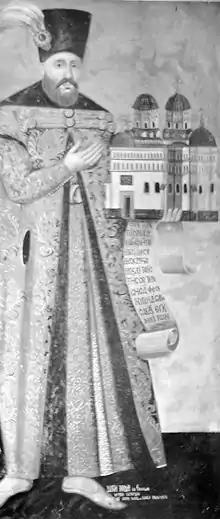| George Ducas | |
|---|---|
 | |
| Prince of Moldavia (1st reign) | |
| Reign | 11 September 1665 – 21 May 1666 |
| Predecessor | Eustratie Dabija |
| Successor | Iliaș Alexandru |
| Prince of Moldavia (2nd reign) | |
| Reign | 8 November 1668 – 10 August 1672 |
| Predecessor | Iliaș Alexandru |
| Successor | Ștefan Petriceicu |
| Prince of Wallachia | |
| Reign | November/December 1674 – 29 November 1678 |
| Predecessor | Grigore I Ghica |
| Successor | Șerban Cantacuzino |
| Prince of Moldavia (3rd reign) | |
| Reign | 28 November 1678 – 25 December 1683 |
| Predecessor | Antonie Ruset |
| Successor | Ștefan Petriceicu |
| Born | ca. 1620 |
| Died | 31 March 1685 Poland |
| Spouse | Anastasiya Dabizha |
| Issue | Constantine Ducas |
| Religion | Orthodox |
Voivode George Ducas (Greek: Γεώργιος Δούκας, Romanian: Gheorghe Duca) (c. 1620 – 31 March 1685) was three times prince of Moldavia (September 1665 – May 1666, November 1668 – 20 August 1672, November 1678 – January 1684) and one time prince of Wallachia (1673 – 29 November 1678).
He was married to Anastasiya Dabizha, the daughter of Eustratie Dabija, and later to Dafina Doamna; George Ducas fathered Constantine Ducas.
First two rules in Moldavia
Gheorghe Duca was of Albanian origin and like many others of his generation who had migrated to the Danubian principalities he rose thanks to his links to other Albanians of high positions. In his youth, another Albanian, Vasile Lupu (voivode of Moldavia) took him to his court where Duca was raised.[1]
Supported by Dafina Doamna and some of the boyars, he came to the throne in Iaşi after Dabija's death, but was soon ousted after his opponents appealed to the Ottomans, unjustly claiming Duca's rule was corrupt.
He contracted large debts in order to reclaim the throne, which he managed to following Iliaș Alexandru's rule. The policy of increased taxation led to the uprising of Mihalcea Hâncu in October 1671, crushed the next year after Ducas received Ottoman help. But, as Ducas failed to provide supplies needed for the War against the Polish–Lithuanian Commonwealth, with the Sultan Mehmed IV's life placed in peril at the attack of Kamianets-Podilskyi, the Ottomans swiftly replaced him with Ștefan Petriceicu.
Rule in Wallachia
In 1674, through the intervention of the Cantacuzino boyars, he was awarded the throne in Bucharest; soon however, the alliance between the Cantacuzinos and Ducas crumbled, the prince being replaced by Șerban Cantacuzino.
Last rule in Moldavia and rule in Right-bank Ukraine

He was soon back on the Moldavian throne, following Antonie Ruset (Rosetti)'s reign.
George Ducas had plans of extending his rule over right-bank Ukraine, where Ottoman gains had started with the acquisition of Podolia in 1672. His overlord appointed him as hetman over the newly gained regions, in 1680 or 1681, after much bribery strained the Moldavian treasury as much as the request that Ducas had placed on the taxed categories that they contribute to his daughter's dowry.
In 1683, Ducas joined the Ottomans in their march at the Battle of Vienna. Helped by his absence and aware of the complete failure of the Ottoman plans, boyars throughout the land rebelled, following Ștefan Petriceicu's command, and welcomed the invading Poles and Cossacks.
On his way back, Ducas was captured on 25 December 1683 and sent to a prison in Poland, where he died one year later.
Bibliography
- Cernovodeanu, Paul (1982). "Ştiri privitoare la Gheorghe Ghica vodă al Moldovei ( 1658– 1659 ) şi la familia sa (I)". Anuarul Institutului de Istorie și Arheologie "A.D. Xenopol." (in Romanian). Institutul de Istorie și Arheologie "A.D. Xenopol.". 19.
- Wasiucionek, Michal (2012). "Ethnic solidary in the wider Ottoman Empire revisited: cins and local political elites in 17th century Moldavia and Wallachia". In Sariyannis, Marinos (ed.). New Trends in Ottoman Studies: Papers presented at the 20th CIÉPO Symposium Rethymno, 27 June – 1 July 2012. University of Crete – Department of History and Archaeology.
- Wasiucionek, Michal (2016). Politics and Watermelons: Cross-Border Political Networks in the Polish-Moldavian-Ottoman Context in the Seventeenth Century (PDF) (Thesis). European University Institute.
- ↑ Wasiucionek 2016, p. 106.